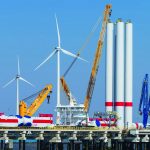As the world’s attention turns towards the landmark COP21 climate negotiations in Paris later this year, the wind industry is in a confident mood; global wind power installations are growing at the fastest pace ever.
A fundamental shift is underway as maturing technology and falling costs are ensuring that wind energy is becoming increasingly competitive with fossil fuels around the world and in many cases, the more economical option for investors.
As a result, wind energy is now the power source of choice for a diverse and growing set of blue-chip companies, ranging from tech giants such as Google and Apple, to automotive heavyweights including General Motors and Renault Nissan.
When Google announced as early as 2007 that the company was going carbon neutral, it included “invest in and use renewable energy sources” as one of its three basic strategies for cutting emissions. Since investing in its first wind farm in 2010, the company has built up a portfolio of three power purchase agreements (PPA) in Europe and nine in total across the world.
 Some corporations, notably IKEA and LEGO, have directly invested in offsite wind farm ownership. LEGO has a commitment to source 100 percent renewable energy by 2020 and recently set an intermediate milestone goal of becoming carbon positive in 2016.
Some corporations, notably IKEA and LEGO, have directly invested in offsite wind farm ownership. LEGO has a commitment to source 100 percent renewable energy by 2020 and recently set an intermediate milestone goal of becoming carbon positive in 2016.
Cost reductions, power purchase agreements, corporate transitions and innovative technologies are just a few of the signs that wind energy has staked its claim as a dominant force in the global energy race.
These are all key issues that EWEA will look at when the association goes to Paris in November for its 2015 annual event.
EWEA will present an international platform for the wind energy industry in Paris to showcase and demonstrate the sector’s latest products and services. The event features a broad conference program, unrivaled networking opportunities and an extensive exhibition.
Malgosia Bartosik, acting CEO of EWEA, said: “Scaling up wind power is crucial to combating climate change. In 2015 the EWEA Annual Event will take place in Paris two weeks before world leaders meet to discuss climate negotiations at the UN Summit in the French Capital. Where better to show the strength of the wind industry!”
Numerous developments of significance in the European market are converging to make this year’s EWEA Annual Event the place to be for new business: European utilities are making a strategic shift towards renewables, the offshore market is booming with 26.4 GW of consented offshore projects in the pipeline, and the focus on efficiency and innovation is translating into new business opportunities for U.S. wind technology and maintenance companies.
On a global level, wind energy is seeing a surge in large markets outside of Europe. In 2014, wind energy was the largest power source in the US and Brazil, while China has ramped up its production steadily, accounting for over more than 40 percent of global installations last year.
GWEC reports that installed global wind power capacity had grown to 370 GW at the end of 2014, with annual installations exceeding 50 GW for the first time. This means that wind power capacity will soon overtake the world’s nuclear fleet.
The best wind projects around the world — for example in the Texas panhandle in the U.S. — are already consistently delivering electricity for $0.05 per kWh without outside financial support. This means onshore wind is easily within the same cost range, and often even lower, as that of fossil fuel generated electricity. When externalities such as the cost of air quality and climate change are factored in, wind in Europe is cheaper than gas, nuclear or coal generation.
Onshore wind is firmly established as one of the lowest-cost sources of electricity available. The global average levelized cost of energy [LCOE] has fallen by around 10 percent since 2010, while turbine prices have fallen by around 30 percent since 2009, with prices in China — the world’s biggest wind power market — having fallen by as much as 35 percent.
The wind sector will continue delivering for corporations, governments and citizens who want affordable, carbon-free and secure electricity supplies. Support from policymakers and large commercial end-users have increased growth opportunities but this also entails important responsibilities for the wind sector to help deliver renewable capacity and lead the way in tackling climate change.
For more information visit www.ewea.org/annual2015.
— Source: EWEA
































